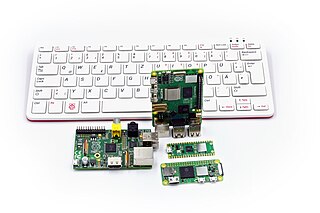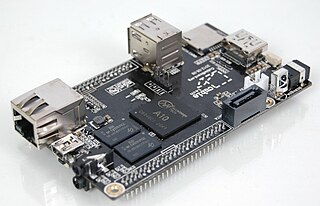ARM is a family of RISC instruction set architectures (ISAs) for computer processors. Arm Ltd. develops the ISAs and licenses them to other companies, who build the physical devices that use the instruction set. It also designs and licenses cores that implement these ISAs.

RISC OS is a computer operating system originally designed by Acorn Computers Ltd in Cambridge, England. First released in 1987, it was designed to run on the ARM chipset, which Acorn had designed concurrently for use in its new line of Archimedes personal computers. RISC OS takes its name from the reduced instruction set computer (RISC) architecture it supports.

Arch Linux is an independently developed x86-64 general-purpose Linux distribution that strives to provide the latest stable versions of most software by following a rolling-release model. The default installation is intentionally minimal so that users can add only the packages they require.

A free and open-source graphics device driver is a software stack which controls computer-graphics hardware and supports graphics-rendering application programming interfaces (APIs) and is released under a free and open-source software license. Graphics device drivers are written for specific hardware to work within a specific operating system kernel and to support a range of APIs used by applications to access the graphics hardware. They may also control output to the display if the display driver is part of the graphics hardware. Most free and open-source graphics device drivers are developed by the Mesa project. The driver is made up of a compiler, a rendering API, and software which manages access to the graphics hardware.

LXDE is a free desktop environment with comparatively low resource requirements. This makes it especially suitable for use on older or resource-constrained personal computers such as netbooks or system on a chip computers.
ARM11 is a group of 32-bit RISC ARM processor cores licensed by ARM Holdings. The ARM11 core family consists of ARM1136J(F)-S, ARM1156T2(F)-S, ARM1176JZ(F)-S, and ARM11MPCore. Since ARM11 cores were released from 2002 to 2005, they are no longer recommended for new IC designs, instead ARM Cortex-A and ARM Cortex-R cores are preferred.

The SheevaPlug is a "plug computer" designed to allow standard computing features in as small a space as possible. It was a small embedded Linux ARM computer without a display which can be considered an early predecessor to the subsequent Raspberry Pi.
The ODROID is a series of single-board computers and tablet computers created by Hardkernel Co., Ltd., located in South Korea. Even though the name ODROID is a portmanteau of open + Android, the hardware is not actually open source because some parts of the design are retained by the company. Many ODROID systems are capable of running not only Android, but also regular Linux distributions.

The ARM Cortex-A15 MPCore is a 32-bit processor core licensed by ARM Holdings implementing the ARMv7-A architecture. It is a multicore processor with out-of-order superscalar pipeline running at up to 2.5 GHz.

Raspberry Pi is a series of small single-board computers (SBCs) developed in the United Kingdom by the Raspberry Pi Foundation in association with Broadcom. Since 2013, Raspberry Pi devices have been developed and supported by a subsidiary of the Raspberry Pi Foundation, now named Raspberry Pi Ltd. The Raspberry Pi project originally leaned toward the promotion of teaching basic computer science in schools. The original model became more popular than anticipated, selling outside its target market for diverse uses such as robotics, home and industrial automation, and by computer and electronic hobbyists, because of its low cost, modularity, open design, and its adoption of the HDMI and USB standards.

Leafpad is a free and open-source graphical text editor for Linux, Berkeley Software Distribution (BSD), and Maemo that is similar to the Microsoft Windows program Notepad. Created with the focus of being a lightweight text editor with minimal dependencies, it is designed to be simple-to-use and easy-to-compile.

The Allwinner A1X is a family of single-core SoC devices designed by Allwinner Technology from Zhuhai, China. Currently the family consists of the A10, A13, A10s and A12. The SoCs incorporate the ARM Cortex-A8 as their main processor and the Mali 400 as the GPU.

Cubieboard is a single-board computer, made in Zhuhai, Guangdong, China. The first short run of prototype boards were sold internationally in September 2012, and the production version started to be sold in October 2012. It can run Android 4 ICS, Ubuntu 12.04 desktop, Fedora 19 ARM Remix desktop, Armbian, Arch Linux ARM, a Debian-based Cubian distribution, FreeBSD, or OpenBSD.

RetroArch is a free and open-source, cross-platform frontend for emulators, game engines, video games, media players and other applications. It is the reference implementation of the libretro API, designed to be fast, lightweight, portable and without dependencies. It is licensed under the GNU GPLv3.

Kali Linux is a Linux distribution designed for digital forensics and penetration testing. It is maintained and funded by Offensive Security. The software is based on the Debian Testing branch: most packages Kali uses are imported from the Debian repositories.
Besides the Linux distributions designed for general-purpose use on desktops and servers, distributions may be specialized for different purposes including computer architecture support, embedded systems, stability, security, localization to a specific region or language, targeting of specific user groups, support for real-time applications, or commitment to a given desktop environment. Furthermore, some distributions deliberately include only free software. As of 2015, over four hundred Linux distributions are actively developed, with about a dozen distributions being most popular for general-purpose use.

The ARM Cortex-A53 is one of the first two central processing units implementing the ARMv8-A 64-bit instruction set designed by ARM Holdings' Cambridge design centre, along with the Cortex-A57. The Cortex-A53 is a 2-wide decode superscalar processor, capable of dual-issuing some instructions. It was announced October 30, 2012 and is marketed by ARM as either a stand-alone, more energy-efficient alternative to the more powerful Cortex-A57 microarchitecture, or to be used alongside a more powerful microarchitecture in a big.LITTLE configuration. It is available as an IP core to licensees, like other ARM intellectual property and processor designs.

Banana Pi is a line of single-board computers produced by the Chinese company Shenzhen SINOVOIP Company, its spin-off Guangdong BiPai Technology Company, and supported by Hon Hai Technology (Foxconn). Its hardware design was influenced by the Raspberry Pi, and both lines use the same 40-pin I/O connector.
This is a comparison of ARM instruction set architecture application processor cores designed by ARM Holdings and 3rd parties. It does not include ARM Cortex-R, ARM Cortex-M, or legacy ARM cores.
Nvidia Jetson is a series of embedded computing boards from Nvidia. The Jetson TK1, TX1 and TX2 models all carry a Tegra processor from Nvidia that integrates an ARM architecture central processing unit (CPU). Jetson is a low-power system and is designed for accelerating machine learning applications.












